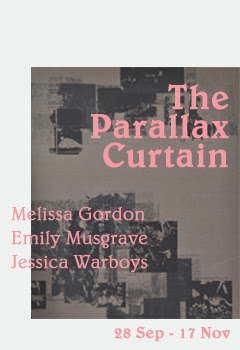28 September - 17 November
S1 Artspace,
120 Trafalgar Street,
Sheffield,
S1 4JT
The Parallax Curtain brings together newly commissioned and existing works including sculpture, painting, performance and video, by three British-based artists, Melissa Gordon, Emily Musgrave and Jessica Warboys.
The title of the exhibition references both a former work by Melissa Gordon [Parallax Curtain, 2006] and the publication The Parallax View [2006] by Slovenian philosopher Slavoj Žižek. A parallax effect describes the phenomena whereby the world and objects around us appear displaced, unfamiliar or changed when viewed from a different position. It is a way of looking from two lines of sight or two opposing points of view - both literally and philosophically. A form of expanded perception, a parallax reveals multiple perspectives in continual flux which in turn create limitless layers of meaning. This concept is invoked by Žižek in The Parallax View and is an approach present in the individual practices of the three artists in this exhibition.
The Parallax Curtain draws together these ideas through the presented works, which, due to each artists’ multiplied approach, share a sense of re-appropriation, renewal and re-presentation. Through extensive research, obsessive cataloguing and process itself, the artists presented in The Parallax Curtain mine the past for forgotten histories and real world events; historical figures; discarded objects with their own silent history; or fictions to retell. Through this process - in addition to a constant editing, collage and layering - resulting works subtlety re-perform these various narratives.
Collectively, the works offer an examination deep within these rediscovered subjects and the promise of revelation, or a drawing back of the curtain. However almost simultaneously, the work implies something hidden, disguised or obscured from view, and any final resolution is playfully deferred. The Parallax Curtain points to theatricality, staging and performance, techniques central to the individual practices of the artists in this exhibition. For Musgrave it is the work that performs, Gordon however invites the viewer to perform with the work, and for Warboys the process of making records a series of performative gestures to be edited within the space they are shown.


